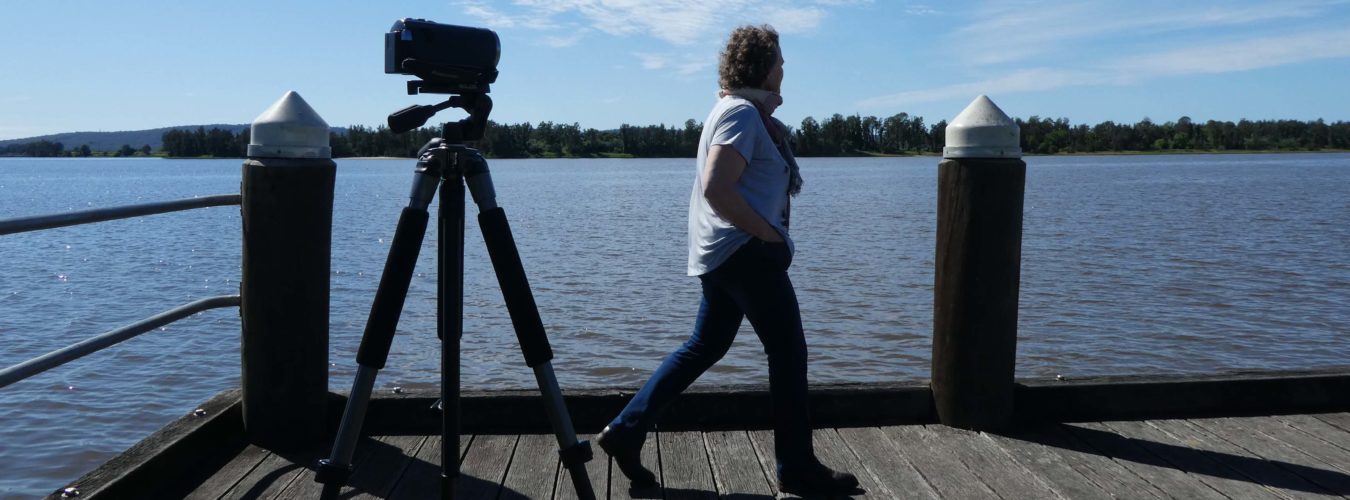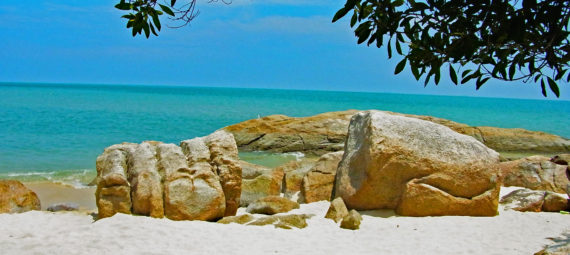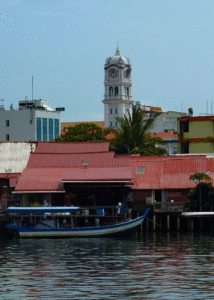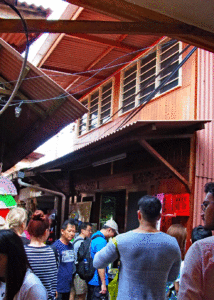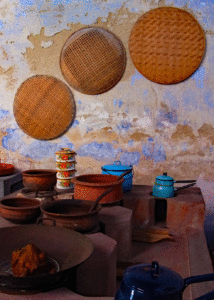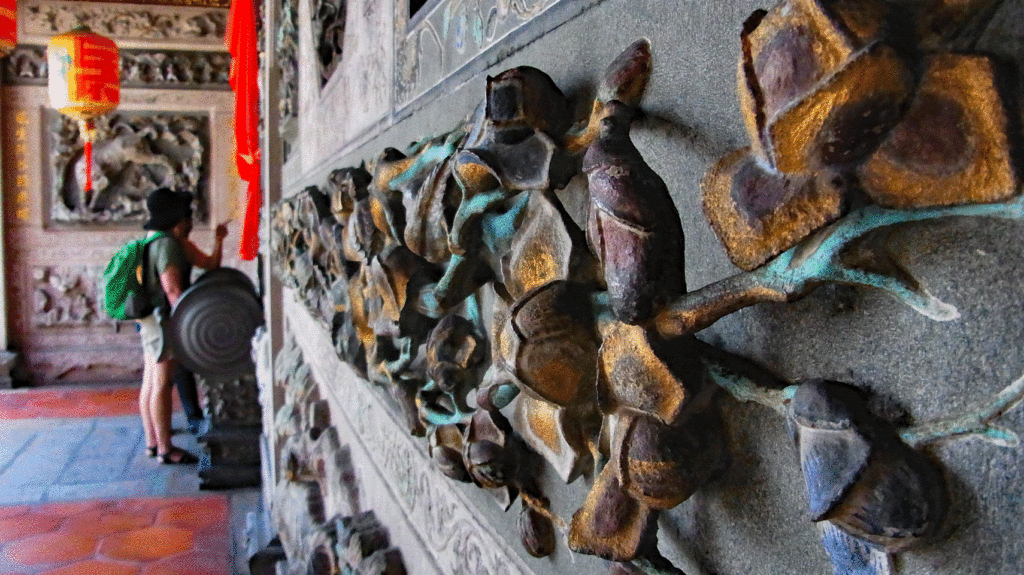What we loved
Penang was easily our favourite part of Malaysia and we wished we’d been able to stay a little longer than the two days of our whirlwind visit. Borneo has it’s natural wonders. Kuala Lumpur has it’s modern delights especially if you enjoy shopping. The Cameron Highlands was a cool oasis and a relief from the ubiquitous heat. But Penang! Here was a fusion of everything we liked about Malaysia – the people,the food, the art, the architecture, the history.

Talk about a melting pot. The capital Georgetown was declared a UNESCO World Heritage site in 2007. The core area of the UNESCO site covers more than 100 hectares and 1700 buildings – its a history buff’s dream. In it’s winding streets you cannot miss the fascinating fusion of British colonialism with Malay, Chinese and Indian traditions. History is everywhere but not in a sterile museum kind of way – it’s a living city. And when we needed a little relief from the glorious hubbub of George Town – there were white sandy beaches, restaurants and gardens of Batu Ferringhi (where we stayed) just an efficient air condition bus ride away.
History in a flash
Fascinating Penang is an island in the north of Malaysia situated at the entrance to the Malacca Strait. It’s had quite a history . The strait was, and still is, one of the most important shipping lanes in the world. Even today tens of thousands of vessels pass through each year carrying about 25% of the world’s traded goods, including oil, Chinese manufactured products, coal, palm oil and Indonesian coffee. Penang was strategically important as a trading port right through it’s history with its protected harbour. Early traders came from the Middle East, Africa, China and Southern India. Many settled in Penang and evidence of their lives and influence are at every turn. British naval captain Francis Light claimed it for the British in 1786. Today it’s under Malaysian control.

What we did
Visit the fort
Visiting Fort Cornwallis is one of those things you really should do while in George Town. Francis Light is considered the founder of Penang (despite the fact that people lived there long before he showed up). He started building the fort in 1786 against possible pirates – but despite its numerous canons, none were ever fired at an actual enemy. Over the years the fort was added to and improved and served as a barracks, administrative centre and these days it’s a tourist attraction. A 9 metre wide, 2 metre deep moat once surrounded the fort but it was filled in the 1920s due to a malaria outbreak.

Pity. Everyone loves a moat. As we wandered the grounds, a helpful guide gave us a run down and helped us conjure up images of soldiers in full uniform sweltering in the tropical heat as they waited for pirates that never turned up. The quarters for the personnel were tiny and must have been horribly cramped and hot. The old canons are interesting as is the old ammunition store. It was carefully constructed to allow ventilation and keep the gun powder a few degrees cooler than the surroundings (which is still hot). There is a lighthouse in the grounds.
Stroll the Clan Jetties
The so called Clan Jetties are survivors from the old Chinese settlements on the island from a century ago. Consisting of wooden buildings on stilts joined by raised walkways, you’ll find them near the main Penang-Butterworth Ferry Terminal. They were used by early stevedores and fishermen – loading and unloading cargo.

Each jetty became associated with a particular Chinese clan group. There was apparently quite a bit of fighting between them too in the old days. The Chew Jetty is good for tourists with a large number of stilt-houses and a temple. It’s a protected piece of local history and it’s not difficult to imagine a very different time. Fishing boats still wait off the jetties.

Chinese influence
The influence of the Chinese in the development of Penang is substantial. Many families became very wealthy. Nowhere is this more obvious than in the UNESCO World Heritage listed site of Leong San Tong Khoo Konsi clanhouse. The site consists of an amazingly rich and ornate temple, a Chinese opera stage and four rows of residential terrace houses around a central courtyard. The temple is covered in intricate shard work, murals, wood and stone carvings.
Now a museum, it shows the history of the Khoo clan, their life and triumphs. One room contains the academic achievements of dozens of family members – many of whom studied in Australian universities. Out the back is a typical kitchen of the time. It’s seriously interesting and beautifully preserved.
Wander the streets of George Town Penang
Yes, it’s very hot – but wandering is the way to go. Pick up any one of the available street maps and set off. The street names in themselves tell a story – China Street, Armenian Street, King Street, and the Indian inspired Chulia and Malabar streets. There is street art at every turn if you look out for it. Some of it so famous that long lines of tourists wait patiently to have their picture taken next to it. Armenian Street was a good example.

Here you’ll find the famous ‘Children on a Bicycle’ mural by Ernest Zacharevic and others. There’s many a good place to eat (and get a cool drink) here and souvenir shops, old buildings and interesting stuff to look at. The Indian section is also interesting and you will smell the delicious smells long before you realise you are in it. The oldest Hindu temple in Penang, Sri Mahamariamman Temple is located here. Just a tip though while you are wandering – ATMs were a bit hard to come by – so get that sorted before you go.

Life’s a beach
Batu Ferringhi is a suburb of George Town on the northern coast of the island about 11km from the city centre. It’s known for its white sand beaches and these days there are several major hotels with glorious views. There’s an evening night market and plenty of good little restaurants. There are very good and inexpensive bus services to and from George Town when you’ve had enough relaxing on the beach.

Spice things up
Given Penang’s location on a major historic spice trade route, and the influence of so many spice loving cultures on its cuisine, we decided to spice things up with a visit to the Tropic Spice Garden at Batu Ferringhi. Built on the site of an old rubber plantation, the garden has hundreds of plant species with an emphasis on spices. Ponds are covered in lilies and little waterfalls tumble across the site.
Trails crisscross the terrain and you can choose between a map, an audio guide or even a guided tour (entry fee varies depending on what you do). If you’re really into your food and have enough time, you can sign up for a cooking class. When you’ve had enough of the walks you can get a delicious meal at the Tree Monkey Restaurant with it’s shady and breezy verandahs overlooking the beach. Then pop into the gift shop to stock up on spices to take home – which after all – is what traders were doing here for centuries.

Where we stayed and what we ate
We stayed at the Bayview Beach Resort at Batu Ferringhi with it’s wonderful views to the west. Well kept swimming pools were popular with visitors and you can get access to the beach from there. Comfortable rooms and well kept facilities – and breakfast included each day. While wandering in George Town we chose the surprisingly named Edelweiss Cafe at 38, Armenian Street. A cool and calm oasis from the heat and craziness outside. It’s set in an old Chinese shophouse with fantastic service and great menu choices.
Another memorable meal was at the excellent value for money Boatman Restaurant, at Batu Ferringhi. The long waited for Penang curry was excellent with a local rice dish and washed down with cold beer. Awesome!
OTHER MALAYSIAN POSTCARDS:
Kuala Lumpur
